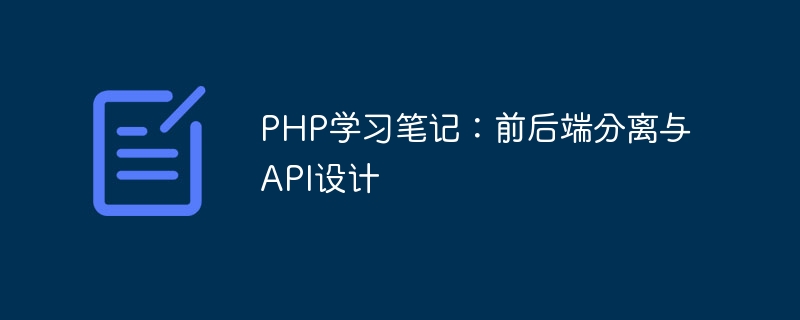Home >Backend Development >PHP Tutorial >PHP study notes: front-end and back-end separation and API design
PHP study notes: front-end and back-end separation and API design
- 王林Original
- 2023-10-08 09:42:141438browse

PHP study notes: front-end and back-end separation and API design
Overview:
With the continuous development of the Internet and the increasing user needs, the front-end and back-end separation The development model is getting more and more attention from developers. Front-end and back-end separation refers to separating the development of the front-end and the back-end, and conducting data interaction through APIs to achieve development efficiency and flexibility. This article will introduce the concept of front-end and back-end separation, and how to design an API.
The concept of front-end and back-end separation:
The traditional Web development model is front-end and back-end coupling, that is, the development of front-end and back-end is carried out in the same project. This model is feasible in small projects, but in large projects there will be problems such as redundant front-end and severe coupling of code. The front-end and back-end separation development model separates the development of the front-end and the back-end, so that the development of the front-end and the back-end can be carried out in parallel to improve development efficiency. The core idea of separation of front-end and back-end is data interaction through API. The front-end obtains data by calling the API, and the back-end is responsible for processing the data and returning it to the front-end.
API design principles:
- Consistency: API naming, parameters, return formats, etc. must be consistent to make front-end and back-end collaboration smoother.
- Simplicity: The API design should be as concise and clear as possible, avoid redundant parameters and return values, and improve the readability and maintainability of the code.
- Security: The design of API should consider security to prevent malicious attacks and illegal operations, such as protection through authentication and access control.
- High performance: API design should consider performance factors, such as minimizing network requests, rational use of cache, etc., to improve the system's response speed and concurrent processing capabilities.
API design example:
The following takes a simple user management system as an example to introduce how to design an API.
- Get user list:
Request method: GET
URL:/api/users
Return value: {
"code": 200,
"message ": "Success",
"data": [
{
"id": 1,
"name": "Zhang San",
"age": 20
},
{
"id": 2,
"name": "李思",
"age": 25
}
]
} - Add user:
Request method: POST
URL:/api/users
Request body: {
"name": "王五",
"age": 30
}
Return value: {
"code": 200,
"message": "Add user successfully",
"data": {
"id": 3,
"name": "王五",
"age": 30
}
} - Update user information:
Request method: PUT
URL:/ api/users/{id}
Request body: {
"name": "王五",
"age": 35
}
Return value: {
"code ": 200,
"message": "Update user information successfully"
} - Delete user:
Request method: DELETE
URL:/api/users/{id}
Return value: {
"code": 200,
"message": "Delete user successfully"
}
Summary:
This article introduces the before and after The concept of end-to-end separation and the principles of API design are discussed, and a simple user management system is taken as an example to show examples of specific API design. The development model that separates the front and back ends can improve development efficiency and flexibility, and is especially suitable for large projects. Not only that, API design is also an important skill that developers must master. Properly designing APIs can improve the maintainability, scalability and security of the system. In practice, we need to rationally design APIs based on the needs and characteristics of specific projects, and follow the principles of consistency, simplicity, security, and high performance.
The above is the detailed content of PHP study notes: front-end and back-end separation and API design. For more information, please follow other related articles on the PHP Chinese website!
Related articles
See more- Is php difficult to learn? How long does it take to learn PHP from beginner to proficient?
- How to use CI framework to separate the front and back ends of the framework
- What technology is used to separate the front and back ends?
- How to solve the single sign-on cross-domain problem by separating the front-end and back-end of vue+springboot

